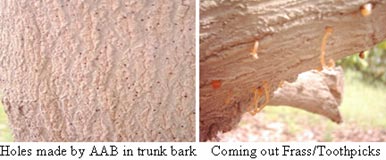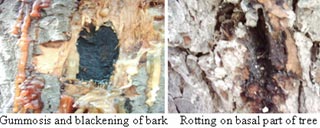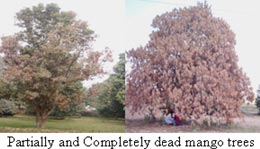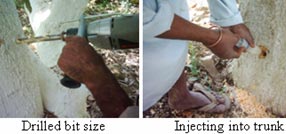AAB monitoring device, cultural practices and chemicals
for management of mango tree mortality
By Dr.
R. D. Khuhro, Dr. S. M. Nizamani, M. M. Jiskani and M.
A. Talpur
Faculty of Crop Protection, Sindh Agriculture University
Tandojam
Mango, Mangifera indica is one of the important
fruits of Pakistan which is exported to many countries
such as Dubai, Saudi Arabia, UK, Germany, France,
Holland, Switzerland, Italy, Singapore and Malaysia. It
is known as “King of Fruits” and is consumed both by
poor and rich people in various forms.
 Mango
is grown is tropical and sub-tropical countries of the
world. In Pakistan, it is grown on large acreages of
Sindh and Punjab provinces. There are numerous varieties
of mango, each differing in fruit characters such as
taste, flavour, colour, tinge, shape and size which
determine the quality of the fruits and market value at
home and abroad (Jiskani, 2002).
Mango
is grown is tropical and sub-tropical countries of the
world. In Pakistan, it is grown on large acreages of
Sindh and Punjab provinces. There are numerous varieties
of mango, each differing in fruit characters such as
taste, flavour, colour, tinge, shape and size which
determine the quality of the fruits and market value at
home and abroad (Jiskani, 2002).Mango tree
plant suffers from various insect pests and diseases.
Among insects, mango hoppers, fruit flies, thrips,
scales, stem borers, shoot borers and mites are reported
(Talpur and Khuhro, 2003; Soomro, 1988). Similarly,
various diseases caused by fungi such as Fusarium,
Aspergillus, Botryodiplodia,
Penicillium and Colletotrichum are also
reported on mango (Hafiz, 1986; Ramos et al.,
1991 and 1997; Wagan et al., 200; Al-Adawi,
2005). During 2002-3 in Pakistan and Sindh, the mango
was grown over an area of 102.8 and 46.5 thousand
hectares and the production was 1034.6 and 335.9
thousand tones per hectare, respectively (Agha, 2004).
Currently, mango trees are dying suddenly at the rate of
2-20%, depending upon severity of disease and management
by the owners of mango orchards.
Causes
Asian
ambrosia beetle (ABB) is considered as the primary cause
of the mango mortality followed by different species of
fungi. Basically, this is a management problem. The
owners of mango gardens give their gardens on contract
and forget about care of the garden whereas, contractors
don’t apply proper fertilizer, cultural and plant
protection practices as per requirement of the gardens.
In this way, the problem of mortality in mango is
multiplying. If this, scenario remain constant, we shall
end up with mango cultivation and loose export exchange
in next few years. The mango growers are warned to
expend at least 10% of their income on management
operations for the sustainability of mango fruit in
their own interest and country at large; therefore,
garden owners must not depend on contractors.
Characteristics of AAB
 The
Asian ambrosia beetle (ABB) has stout dark reddish-brown
body and is reported as pest on broad host range
including woody ornamentals, fruit and nut trees
(Atkinson et al., 1988; Kovach, 1986). Schedl
(1962) reported 124 hosts of ABB. The beetle has been
collected and identified from various samples taken from
dead or partially dead mango trees, Shisham, Gold Mohar,
Gular, Neem, Eucalyptus, Siris Albizzia lebbek,
rubber plant and Casia fistula from various
ecological zones of Sindh. Only females have wings and
disperse with small movement from infested and dead
mango trees, wood logs/pieces and by its own short
movements. These beetles are so tiny that initially
attacked trees, don’t show symptoms.
The
Asian ambrosia beetle (ABB) has stout dark reddish-brown
body and is reported as pest on broad host range
including woody ornamentals, fruit and nut trees
(Atkinson et al., 1988; Kovach, 1986). Schedl
(1962) reported 124 hosts of ABB. The beetle has been
collected and identified from various samples taken from
dead or partially dead mango trees, Shisham, Gold Mohar,
Gular, Neem, Eucalyptus, Siris Albizzia lebbek,
rubber plant and Casia fistula from various
ecological zones of Sindh. Only females have wings and
disperse with small movement from infested and dead
mango trees, wood logs/pieces and by its own short
movements. These beetles are so tiny that initially
attacked trees, don’t show symptoms.
 In
case of severe infestation, the small pin head sized
holes appear with the inside and outside movement of
beetle on bark. The beetles excavate galleries in the
branches, trunks, roots and twigs. The beetles introduce
fungi complex in the mango tree and lay their eggs in
clusters. In some mango trees no holes in bark appear
but black spots on the basal parts of trunks are
present. After cutting those barks, the light yellow
paste with bad odour watery secretion flows. The beetles
are also present in infested black basal part of the
trunk.
In
case of severe infestation, the small pin head sized
holes appear with the inside and outside movement of
beetle on bark. The beetles excavate galleries in the
branches, trunks, roots and twigs. The beetles introduce
fungi complex in the mango tree and lay their eggs in
clusters. In some mango trees no holes in bark appear
but black spots on the basal parts of trunks are
present. After cutting those barks, the light yellow
paste with bad odour watery secretion flows. The beetles
are also present in infested black basal part of the
trunk.
 The
gum like secretion/drops commonly known as gummosis
oozes out from holes of trunks/branches of mango trees
infested with beetle. The “C” shaped, legless, white
grubs of beetle are found feeding on inner darkened
portion of barks.
From
the infested trunk of the mango tree, the frass of the
beetle is pushed out of galleries, in a typical
tooth-pick fashion.
The
gum like secretion/drops commonly known as gummosis
oozes out from holes of trunks/branches of mango trees
infested with beetle. The “C” shaped, legless, white
grubs of beetle are found feeding on inner darkened
portion of barks.
From
the infested trunk of the mango tree, the frass of the
beetle is pushed out of galleries, in a typical
tooth-pick fashion.
Management:
A.
Asian ambrosia beetle monitoring device
·
Various
research experiments have been conducted and are in
progress at Sindh Agriculture University, Tandojam under
Mango Research Project sponsored by Higher Education
Commission, Islamabad. On the basis of these preliminary
experimental results, it is suggested that apply sticky
traps of 1sq.ft. size by pasting grease on plastic
sheets (coated over cloth) at the rate of 10-15 traps
per acre at the height of 1-3 ft from ground level for
catching the winged female beetles. It was also observed
that green colour sticky trap attracted more female
beetles followed by black and other colours.
B. Cultural
·
Regular
monitoring of mango gardens for bark beetle and
development of decline symptoms is compulsory.
·
Prune
diseased branches along with 4-5 inches of healthy
portion with saw and apply bordeaux paste at the rate of
1:1:10 (1kg CuSO4+1kg lime+10 liters of
water)on the cut points in July-August.
·
Removal
and burning of diseased/dead mango trees including
roots.
·
Avoid
wounding the trunks and roots during pruning,
inter-culturing and fruit picking. In case of wounds,
Bordeaux paste may be applied.
·
Plowing/inter-culturing and other sanitation practices
followed by pruning of gardens in July-August.
·
Soil
testing is compulsory for application of proper chemical
fertilizers. Zinc sulphate and other macro and micro
nutrients may be incorporated on the basis of soil
testing.
·
Proper
irrigation application as and when required but not on
the basis of availability of water.
C.
Chemical
·
Apply
Lorsban 40 EC or any other systemic insecticide in
combination with Alliete fungicide just after fruit
setting.
·
The
same spray may be repeated at the interval of 15-21
days.
·
Apply 3rd
spray in September/October.
Method
of application
 ·
Generally foliar pesticide is carried out but in this
case washing of trunks and branches through spraying or
similar to white wash is suggested.
·
Generally foliar pesticide is carried out but in this
case washing of trunks and branches through spraying or
similar to white wash is suggested.
The
same pesticides can also be applied by drilling followed
by injecting in main trunk and its primary branches deep
up to 6".
The writer
is parmanent contributer of Pakissan.com